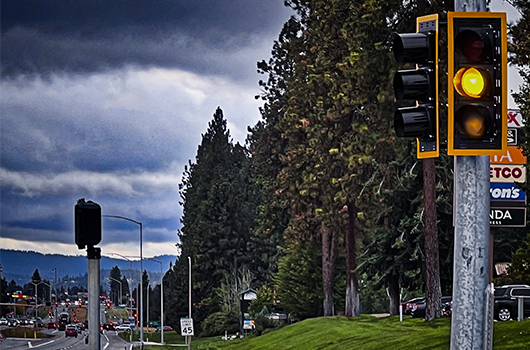Since mid-September, drivers in North Idaho may have noticed a change to late-night driving on U.S. Highway 95 through Coeur d’Alene. Previously, signals through the corridor used to flash yellow or red during late night hours to allow drivers already on the highway more mobility while traffic volumes were low. That pattern is no more, having been replaced by a detection and activation system designed to improve safety and prioritize northbound and southbound traffic flow.
“There are a variety of factors that influenced this change,” said Damon Allen, the district engineer for the Idaho Transportation Department (ITD). “The primary driving factor behind this change is safety.”
In recent years local law enforcement agencies have reported an uptick in late night near-miss crashes at signalized intersections with more drivers entering US-95 from side streets failing to yield.
“If you look at the data, moving away from any sort of nighttime flash pattern is trending nationwide, and the reason is safety,” Allen said.
According to ITD Engineer Manager Lee Bernardi who oversees the traffic section, problems arose from drivers on side streets not realizing that northbound and southbound traffic on US-95 had a flashing yellow light, rather than a flashing red. Signals are not designed for other-directional traffic to be able to see the lit color, so it’s understandable for a driver attempting to cross US-95 with a flashing red to assume opposing traffic also has a flashing red, and would treat it as a four-way stop rather than yielding to oncoming vehicles.
Bernardi continued, “As drivers, we’re conditioned to treat flashing red lights one way, and flashing yellow lights entirely differently. Maintaining complex intersections that combine these two conflicting behaviors, coupled with the amount of growth this area has seen in recent years, it’s logical to transition to a solution that eliminates assumptions on the part of motorists.”
In addition, updating to a nighttime activation system will keep the corridor uniform with the functionality of other signals throughout the area managed by local highway districts and cities.
“It makes sense for drivers to have the same expectations on all primary roadways in the area regardless of jurisdiction or time of day, and eliminating the nighttime flash on US-95 through Coeur d’Alene does exactly that,” said Allen.
The good news for drivers is that, despite this recent change, there should be a relatively low impact to their late-night mobility. Thanks to recent radar and detection equipment upgrades at every intersection along US-95 between Interstate 90 and Lancaster Road, each signal can operate independently of timing cycles and relies simply on a ‘see it and serve it’ strategy.
Each night, when the signals change over to the activation schedule, northbound and southbound lights are designed to rest on green, prioritizing the primary flow of traffic. Typically, the only time the flow of US-95 should be interrupted is when the signals detect either turning or cross-street traffic waiting at an intersection. The lights will quickly transition to serve those waiting vehicles and then get right back to green, rather than having to wait through a timing cycle for each lane. Likewise, cross street traffic should notice a decrease in wait times to get through an intersection.
“Our primary goal is to keep traffic moving,” said Allen. “We want drivers to remember that we are also in the business of efficiency, while maintaining a balance between mobility and safety for everyone on the road.”

